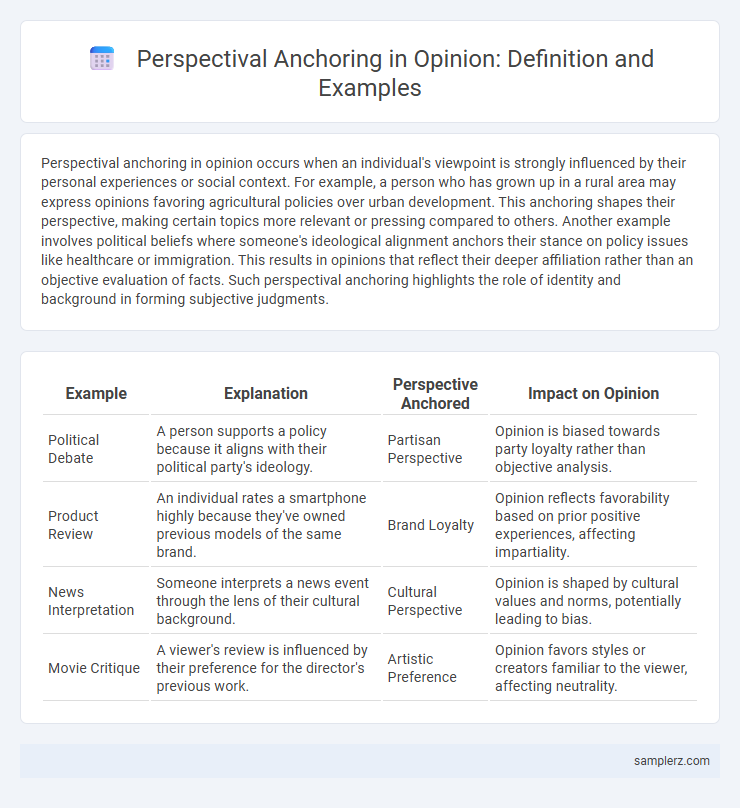Perspectival anchoring in opinion occurs when an individual's viewpoint is strongly influenced by their personal experiences or social context. For example, a person who has grown up in a rural area may express opinions favoring agricultural policies over urban development. This anchoring shapes their perspective, making certain topics more relevant or pressing compared to others. Another example involves political beliefs where someone's ideological alignment anchors their stance on policy issues like healthcare or immigration. This results in opinions that reflect their deeper affiliation rather than an objective evaluation of facts. Such perspectival anchoring highlights the role of identity and background in forming subjective judgments.
Table of Comparison
| Example | Explanation | Perspective Anchored | Impact on Opinion |
|---|---|---|---|
| Political Debate | A person supports a policy because it aligns with their political party's ideology. | Partisan Perspective | Opinion is biased towards party loyalty rather than objective analysis. |
| Product Review | An individual rates a smartphone highly because they've owned previous models of the same brand. | Brand Loyalty | Opinion reflects favorability based on prior positive experiences, affecting impartiality. |
| News Interpretation | Someone interprets a news event through the lens of their cultural background. | Cultural Perspective | Opinion is shaped by cultural values and norms, potentially leading to bias. |
| Movie Critique | A viewer's review is influenced by their preference for the director's previous work. | Artistic Preference | Opinion favors styles or creators familiar to the viewer, affecting neutrality. |
Understanding Perspectival Anchoring in Opinion Writing
Perspectival anchoring in opinion writing occurs when authors present arguments rooted in their unique viewpoints, shaping the interpretation of facts and evidence. This technique influences readers by aligning the narrative with specific cultural, social, or ideological frameworks, thereby framing the opinion in a particular context. Understanding perspectival anchoring is essential for critically evaluating bias and recognizing the layers that affect the formation and communication of personal or collective opinions.
How Personal Experience Shapes Opinion Anchors
Personal experience acts as a fundamental anchor in shaping opinions by providing concrete and relatable reference points. Individuals interpret information through the lens of their own memories and encounters, which biases their judgments toward familiar contexts. This perspectival anchoring explains why opinions often vary significantly even when people are exposed to the same facts or evidence.
Cultural Influences on Perspectival Anchoring
Cultural influences significantly shape perspectival anchoring by framing individuals' opinions within shared values, beliefs, and social norms prevalent in their communities. For instance, collectivist cultures tend to anchor opinions around group harmony and social roles, while individualist cultures prioritize personal freedom and self-expression, leading to differing interpretations of the same issue. These cultural anchors bias judgment and opinion formation by emphasizing culturally reinforced perspectives over alternative viewpoints.
Perspectival Anchoring in Political Opinion Pieces
Perspectival anchoring in political opinion pieces often manifests through the selective emphasis on particular events or policies that reinforce the writer's ideological stance, shaping readers' interpretation based on narrowly framed narratives. This anchoring leverages cognitive biases by presenting information through a partisan lens, which influences public perception and entrenches existing political divides. Analyzing opinion columns in major newspapers reveals persistent patterns of anchoring that align with the publication's editorial stance, underscoring the strategic construction of political discourse.
The Role of Language in Anchoring Perspectives
Language functions as a powerful tool in anchoring perspectives by framing opinions through specific word choices and narrative structures. Semantic nuances and connotations embedded within terminology guide audiences toward particular interpretations, reinforcing subjective viewpoints. This dynamic illustrates how linguistic framing shapes not only the content but also the reception and anchoring of opinions in cognitive frameworks.
Emotional Anchors in Forming Opinions
Emotional anchors significantly influence opinion formation by attaching personal feelings to specific beliefs or experiences, creating biased perspectives that shape judgment. For example, a person who experienced loss during a natural disaster may develop a strong emotional attachment influencing their opinion on disaster preparedness policies. This emotional anchoring distorts objective evaluation, leading to opinions deeply rooted in personal affect rather than neutral analysis.
Media Bias and Its Perspectival Anchors
Media bias often manifests through perspectival anchoring, where news outlets frame stories based on ideological positions that shape audience interpretation. Anchors such as selective source citation, emphasis on particular facts, and narrative framing serve to align information with the outlet's political or cultural stance. This anchoring influences public opinion by reinforcing existing beliefs and limiting exposure to diverse viewpoints.
Perspectival Anchoring in Social Media Discourse
Perspectival anchoring in social media discourse shapes opinion by aligning individual viewpoints with dominant community narratives, often reinforcing group identity through selective framing of events or issues. This cognitive bias manifests when users adopt and amplify perspectives prevalent within their social networks, leading to echo chambers that limit exposure to diverse opinions. Such anchoring affects how information is interpreted and shared, influencing public sentiment and collective attitudes on platforms like Twitter and Facebook.
Anchoring Through Historical Comparison in Opinion Articles
Anchoring through historical comparison in opinion articles often shapes readers' perspectives by linking current events to familiar past occurrences, such as comparing modern political unrest to the civil rights movements of the 1960s. This technique leverages collective memory, making contemporary issues more relatable and easier to interpret through established narratives. By framing opinions within historical contexts, writers influence public perception and underscore the significance or urgency of present-day debates.
Challenging Anchored Perspectives in Reader Commentary
Challenging anchored perspectives in reader commentary reveals how initial opinions create cognitive biases that influence interpretation of subsequent information. Readers often anchor on their first impressions, making it difficult to objectively evaluate contrasting viewpoints or evidence. Engaging critically with these anchored perspectives promotes a more nuanced understanding and fosters open-minded discourse.

example of perspectival anchoring in opinion Infographic
 samplerz.com
samplerz.com